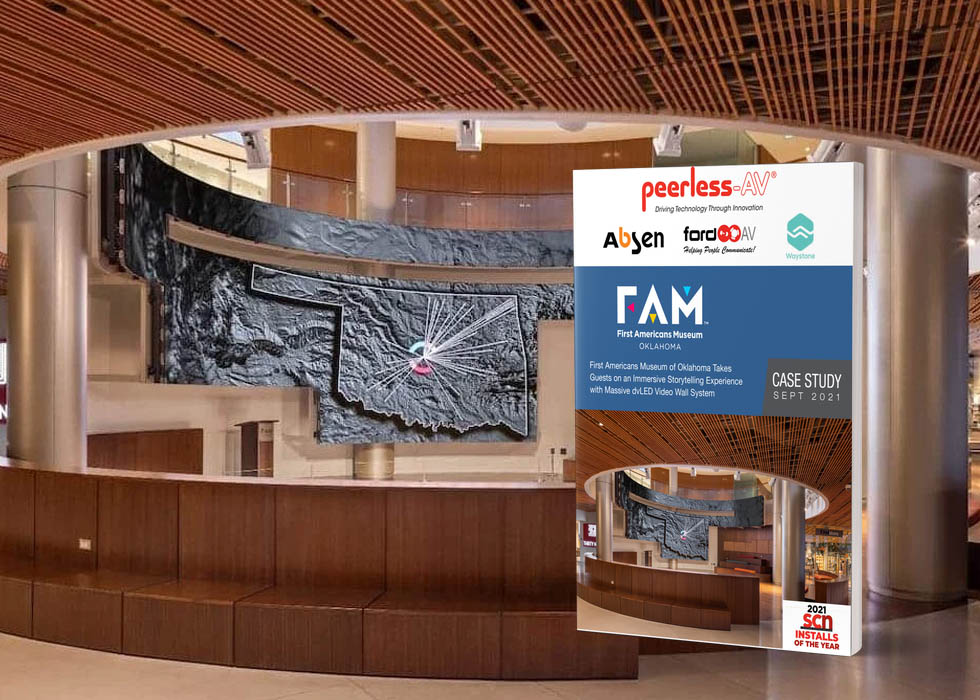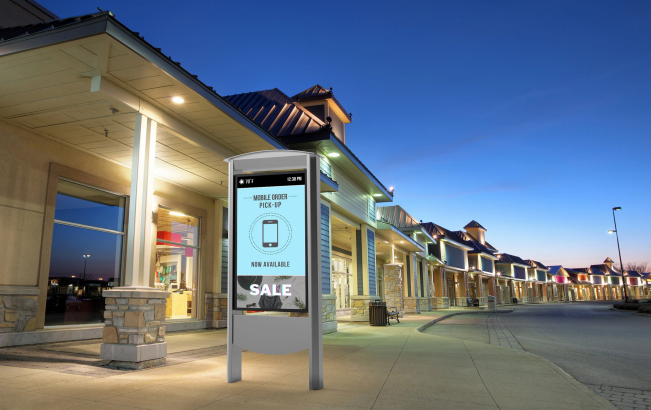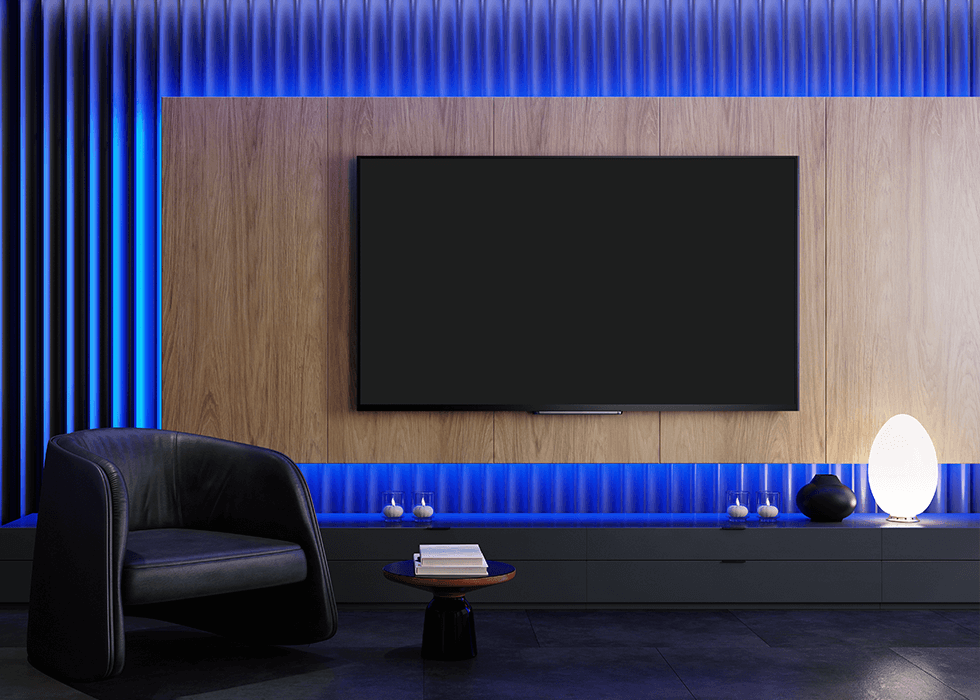
Video Wall Solutions: What to Know Before Installation
We're living in a time where walls can talk, educate, and captivate—they’re known as video walls. But harmoniously combining technology, design, and messaging requires thoughtful consideration. So, we bring you this must-read guide on the basics of video wall design, where we break down various display types and key considerations.
Video Wall Definition
Let’s start with the basics. What is the definition of a video wall? Well, a video wall is a unique formation made of numerous computer monitors, video projectors, or television sets that have been tiled or layered together to create one big screen. It can display various content on each monitor or function as one unified colossal display.
Due to the flexibility and scalability of video walls, they’re useful in various industries, as recognized by many Fortune 500 firms and brands.
Video Wall Solutions
When you examine the places where a large video display is useful, the applications are virtually boundless. Hospitality, retail, security, and educational institutions remain among the most typical applications. Video walls are utilized in conferences, museums, restaurants, hotel lobbies, casinos, and houses of worship. Whether you want to create a dynamic art installation, produce an eye-catching curved video wall for your store, or make a dynamic stage backdrop, video walls could be a helpful route for you to take. Keep in mind that each display technology has its pros and cons, catering to different needs in various industries.
Understanding the cultural and psychographic characteristics of your audience, such as attitudes, interests, lifestyle, and values, can considerably increase the effectiveness of your video wall. And when it comes to video walls, ensuring accessibility and inclusivity means guaranteeing that your content is clearly understood as well as appreciated by all viewers, regardless of physical abilities or cultural backgrounds.
Video Wall Processor
To make a video wall work, you’ll need processing and control systems that can communicate with your display. Each video source is routed to the appropriate screen at its suitable resolution thanks to video wall processors. These processors can transport a video from one source to a single screen or distribute an image across several screens. In some instances, processors can even incorporate videos from multiple sources.
But what’s the best way to build a video wall? There are several considerations to keep in mind before installing a video wall, such as the desired display type, resolution, and more. Let’s get into them.
Display Type
One of the most imperative decisions in the design process is choosing the display type. The display technology will be the heart of your video wall. Video walls can be assembled using many kinds of displays, with each type having its own unique characteristics and trade-offs.
Some of the most common display types include:
- Light-Emitting Diode (LED)
- Organic Light-Emitting Diode (OLED)
- Liquid Crystal Display (LCD)
- Projection Technology
- Rear-Projection Cubes
LED, OLED, and LCD tend to be the most popular choices, but depending on your project, you may consider using projection technology or rear-projection cubes. Let’s explore these display options further.
LED Displays
Light-Emitting Diode (LED) screens are among the most popular choices for video walls. An LED wall would work exceptionally well for outdoor or large-scale applications due to the high brightness, vibrant colors, excellent contrast ratios, and longevity of LEDs.
OLED Displays
Organic Light-Emitting Diode (OLED) displays are more suitable for darker environments or applications where high contrast is desired. They offer excellent color reproduction and contrast ratios, known for their ability to produce deep blacks and vibrant colors. However, they’re typically more susceptible to burn-in and have a shorter lifespan than LEDs.
LCD Displays
Liquid Crystal Display (LCD) panels are another common choice. They’re typically the most cost-effective option and provide good all-around performance, but they may not have the brightness needed for outdoor use or the contrast ratio desired for high-end applications. They also may not offer the same seamless flexibility as LEDs, but they provide good image quality and are often available in a range of sizes.
Projection Technology
Projection-based video walls use projectors to display images on a large screen. While less common than direct-view displays like LED, OLED, and LCD, projection walls are still used in certain applications.
Rear-Projection Cubes
These are cube-shaped displays where images are projected onto the rear surface of the cube. Installing rear-projection cubes involves arranging multiple cubes in a grid formation and ensuring the projection is uniform across the display. Rear-projection cubes are often used in control room settings and offer good visibility from various angles. They generally provide good image quality but might not match the pixel density of some direct-view displays.
The choice of technology depends on factors such as budget, space constraints, viewing environment, and specific visual requirements. It’s also important to remember that each display technology has different cooling requirements.
Resolution
The ideal technology varies depending on the desired resolution. The resolution of your video wall refers to the total number of pixels that can be displayed. The higher the resolution, the more detailed and crisper an image will be.
Understanding the intended viewing distance and content type is crucial for determining the appropriate resolution. The size of the screen will significantly influence the wall's impact, the viewing distance, and the overall spatial design. Moreover, it is directly correlated with the resolution of the video wall—larger screens may necessitate higher resolutions for optimal image quality.
The aspect ratio, representing the width-to-height ratio of the screen, is also pivotal. While conventional ratios such as 16:9 or 4:3 are suitable for many applications, non-standard ratios offer opportunities to craft distinctive and engaging video walls. Direct-view displays often provide high resolutions, ranging from Full HD (1080p) to 4K and beyond. High-end projectors can support resolutions up to 4K or more but achieving the same pixel density as direct-view displays may require careful calibration and other equipment.
In situations where viewers will be close to the video wall, opting for high-resolution LED monitors would be preferable. Conversely, lower-resolution solutions are viable options for displays visible from a distance, such as those in stadiums.
Physical Space
Your choice of mounting and installation method will mainly depend on your physical space and design goals. People also get creative with it—it's not uncommon to see video walls mounted on curved surfaces or built into corners.
Keep in mind that projection technology requires additional space for projectors and may be affected by the distance and angle of projection. The choice of projection surface is essential for achieving optimal image quality as well. Additionally, rear-projection cubes are typically larger and bulkier, requiring sturdy mounting structures. They’re often installed in a dedicated space, such as a control room.
A video wall also requires proper lighting conditions, so consider the potential for glare or reflections. Luckily, anti-reflective technologies or display orientations minimize the impact of glare. But while direct-view displays like LED, OLED, or LCD can be designed with anti-glare coatings or technologies to minimize reflections, projections rely on a clear and controlled projection surface. Glares and reflections in projection setups can be influenced by factors such as the type of screen or surface used, the ambient lighting conditions, and the positioning of projectors. Using specialized projection screens designed to minimize reflections and ambient light interference can help mitigate these issues.
Electrical Requirements
The electrical requirements are also paramount to consider during the planning phase. In terms of electrical requirements, calculate the total power draw of your video wall and make sure that your facility's electrical system can handle the load. Overlooking this step could lead to electrical failures (or even fire hazards)! Direct-view displays, projection technology, and rear-projection cubes differ in electrical requirements, so that should be kept in mind.
Software
Video wall software spans a broad spectrum of capabilities, ranging from basic single-source content management to intricate multi-source, multi-zone management systems equipped with interactive features. Working hand in hand with the software, video wall controllers receive incoming content signals and efficiently distribute them across the screens. Certain controllers offer the option to stretch a single content source across all screens, a mode commonly referred to as "video wall mode." In contrast, others can handle multiple content sources displayed on individual screens or zones. Direct-view displays and projection-based video wall displays typically use video wall controllers and management software to organize and display content seamlessly across multiple screens. However, projection setups may include additional features for edge blending and warping to ensure a seamless image across multiple projected surfaces. The software for rear-projection cubes is designed to manage synchronization and calibration between individual cubes, providing a cohesive display.
Network Infrastructure
Additionally, the network infrastructure of a video wall system is the unseen but critical framework that connects every component, regardless of whether you choose direct-view displays, projection technology, or rear-projection cubes. A robust and reliable network infrastructure is key.
Additional Considerations for Set-up
It's important to keep environmental factors in mind, as they can significantly affect your video wall’s performance and longevity. If your video wall is in a non-climate-controlled environment or outdoors, it's necessary to invest in displays designed to withstand the elements.
Dust and debris are the silent killers of electronics. Dust can clog up ventilation systems and may lead to overheating. On the other hand, debris can scratch or damage screens. Therefore, if your video wall is in a dusty environment or outdoors, it's vital to choose displays with appropriate dust and debris protection. Additionally, regular cleaning and maintenance can assist in keeping dust and debris in check.
In high-noise or vibration-prone environments, consider soundproofing and vibration isolation. However, some display technologies, such as LED, are inherently more resistant to vibration than others.
Ensuring proper electrical installation and grounding is imperative for both the safety and optimal functionality of your video wall. Lastly, ensure that your video wall installation adheres to all pertinent safety regulations and standards.
In Closing
To summarize, building a video wall begins with careful planning and precise installation. During the planning phase, consider the video wall display types available, such as LED panels or projectors, and evaluate their advantages and drawbacks. LED, OLED, and LCD displays are among the most popular choices, but depending on your project, you may consider using projection technology or rear-projection cubes. The choice between these technologies should mainly consider the specific application’s requirements, budget constraints, and desired image quality.
Video walls offer benefits like increased visibility, improved engagement, and enhanced communication. They provide a larger canvas for displaying content, making them ideal for conveying information in control rooms, advertising in retail spaces, or creating immersive experiences in events. Their modular nature allows for flexibility in configuration and easy scalability.









